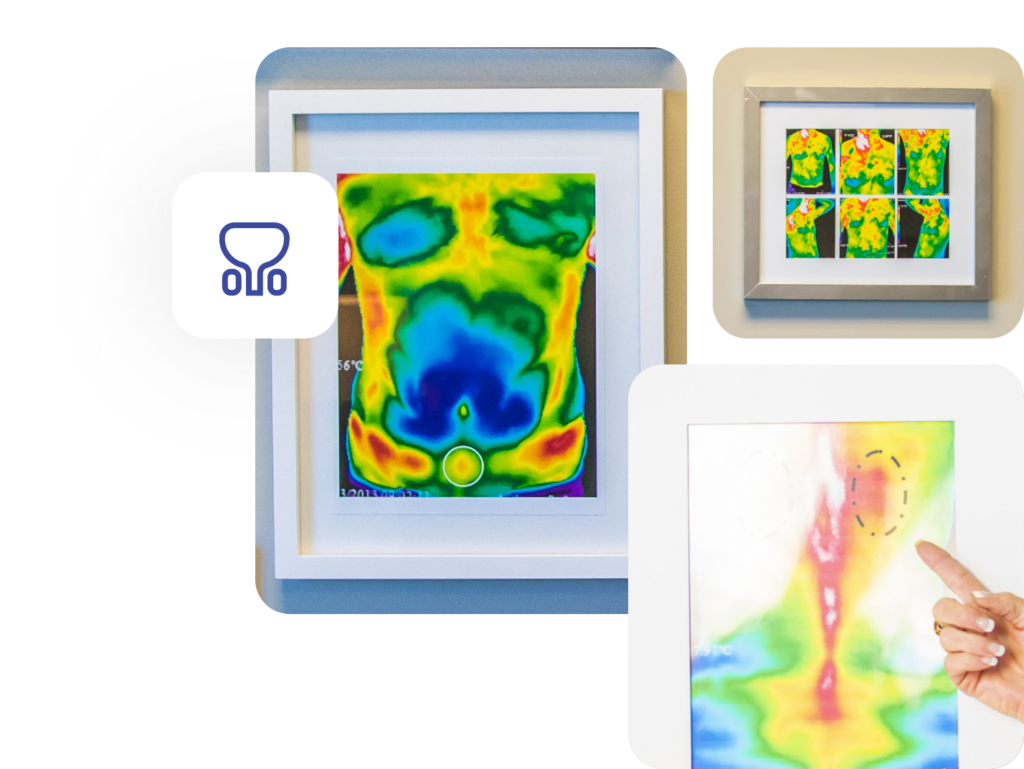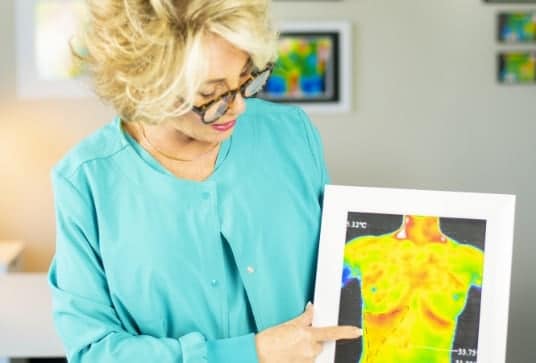
Services
Prostate & Testicular Thermography
One in nine men will be diagnosed with prostate cancer at some point in their lifetime in the US; it is currently the second leading cause of cancer death in American men, behind lung cancer.
Prostate and Testicular Thermography uses advanced thermal imaging to detect any potential or present health issues relating to the prostate and testicular areas.

Overview Breakdown
Prostate & Testicular Thermography
We can identify any abnormal heat patterns that may suggest inflammation or other possible conditions, even prior to any symptoms!
Our examinations include a thorough scan of the following:
- lymphatic congestion of the groin and lower pelvic region
- stomach, diaphragm, gallbladder, liver, large and small intestines, ascending and descending colon
- intestinal inflammation
- testicles and prostate marker region
Results include a comprehensive report of clinical interpretive findings, any recommendations, and a color copy of each image taken.

We follow a step-by-step process to ensure you receive the best care and results for your scans:
01
Intake Forms and Symptom Survey
Upon arrival, you will fill out intake forms and a symptom survey. This includes details about your past surgeries, current symptoms, any areas of discomfort, and so on.
02
Consultation
After completing the forms, we sit down with you to discuss your symptom survey in depth. This consultation is a crucial part of the process as it allows us to thoroughly explore your medical history, understand your current symptoms, and answer any questions you may have about thermography. For many clients, their knowledge of thermography may be limited or they may have learned about it through social media platforms like TikTok, so we take the time to educate you about the process and its benefits.
03
Initial Scan Process
As Certified Clinical Thermographers (CCT), our role is akin to that of an x-ray technician in conventional medicine. We perform the thermal imaging scans, then send the images to Dr. Gregory Melvin, our Board Certified Clinical Thermologist. He reads and analyzes the images and then creates a detailed report of findings.
04
Post-Scan Plan
Once Dr. Melvin has interpreted the results, we discuss the findings with you and address any acute issues. From there, we come up with a plan for future scans and interventions based on these findings.
05
Follow-Up Scans (Recall)
After the initial scan, we typically recommend follow-up scans to track the client’s progress and changes in their thermal patterns. These usually occur three months, six months, and 12 months after the initial scan. The goal of these follow-up scans is to compare the results with the baseline obtained during the initial visit, and ensure everything is moving in the right direction. Finally, we advise yearly scans for ongoing monitoring and proactive health care.
Prostate & Testicular Thermography
Thermography Statistics
- In 2023, there were approx. 9,190 new cases of testicular cancer diagnosed and 470 deaths from testicular cancer.
- About 1 of every 250 males will develop testicular cancer at some point during their lifetime.
- Testicular cancer is 96% curable with early detection.
- Since the early 1990s, early detection and better therapy have significantly reduced prostate cancer deaths by 40 to 50 percent.

Select The Scan That’s Right For You
Full-Body Scan
Our full body scan is our most popular scan and our most comprehensive study; the most complete medical scan available.
- Varicosity
- Phlebitis
- Plantar fasciitis
- Circulatory and nerve damage related issues
- Neuropathy
- Pancreatic issues
- Pre-diabetic developments
- Everything included in the Half-Body Scan
- Everything included in the Breast Screening Scan
- … and so much more
Half-Body Scan
Top of the head to the pubic bone. Includes 19 images.
- Full cranial
- Deep-rooted periodontal issues (often missed on dental x-rays)
- Comprehensive thyroid
- Carotid artery
- Coronary issues
- Complete breast scan (note breast scan details)
- Lymphatic congestion and lymph node activity above the clavicle and under the arms
- Full spine (upper and lower back)
- Major organs: stomach, diaphragm, gallbladder, liver, large and small intestines, kidneys, ascending and descending colon, ovaries, uterus, bladder, etc.
- Intestinal inflammation
- … and more
Prostate & Testicular Thermography
Thermography FAQs
Chronic inflammation in the lower pelvic floor from pressure due to improper digestion often causes an environment that fosters prostate cancer. Only thermography can screen for chronic inflammation that may be fostering an environment for prostate cancer to thrive – not a PSA test.
Using infrared screening tools, we can detect variations and irregularities in temperature and heat patterns throughout your genitalia, which may suggest certain abnormalities such as inflammation or tumor growth.
Prostate thermography is a non-invasive, non-contact system of recording body temperature by measuring infrared radiation emitted by the body surface, therefore there are typically no side effects to the procedure.
